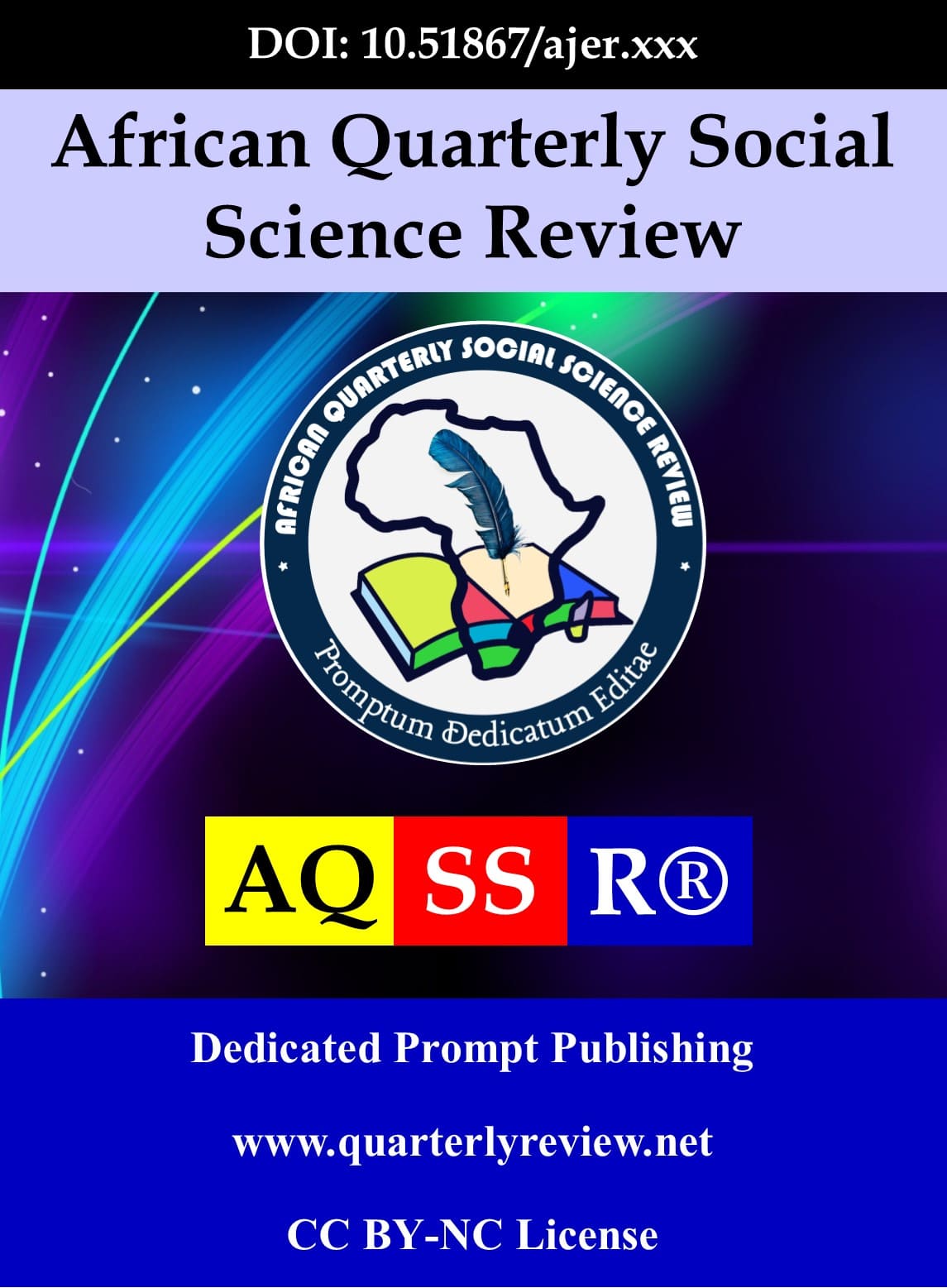Everyday WhatsApp realities in Tanzania: How communication practices shape interpersonal relationships
DOI:
https://doi.org/10.51867/AQSSR.2.4.2Keywords:
Communication, Family, Interpersonal Relationships, WhatsAppAbstract
WhatsApp has gained great attention among the public in both developed and developing countries; the study aimed to assess how communication practices shape interpersonal relationships. The study employed the family communication patterns theory. This study employed a cross-sectional design, combining statistical and descriptive methods to achieve comprehensive and consistent results. Specifically examining the practice of family communication through WhatsApp and the effects of WhatsApp on enhancing interpersonal relationships. The study included all household heads aged 18 and above, including those who do not live with all their family members, such as children, parents, spouses, or siblings, but who use WhatsApp regularly to communicate with them, whereby 153 respondents were sampled using a formula for an unknown population. Data were collected using a designed questionnaire administered to heads of households and checklists for key informants. Data were analyzed using quantitative and qualitative methods to examine WhatsApp use in household communication practices comprehensively. The study indicates that the majority of the respondents had been using WhatsApp for four to ten years. Furthermore, daily engagement with family on WhatsApp was high, whereby the majority of the respondents reported communicating with relatives daily. Regarding daily WhatsApp time with family, most spent between 10 and 30 minutes per day. In addition, the average responses of the respondents ranged from 3.02 to 3.42, indicating a medium to high level of agreement regarding the contribution of WhatsApp to family relationships. Thus, the study concludes that WhatsApp has become an important tool for family communication among many Tanzanian households, especially among young and middle-aged people who are accustomed to technology. The platform has successfully reduced travel expenses, bridged geographical gaps, and facilitated frequent communication with emotional support. The study recommends that families should continue using WhatsApp to strengthen and maintain emotional connections and bonds, facilitate coordination of family activities, and use video, voice, and photo features to make their communication more authentic.
References
Al-Azzeh, D., & Diab, J. L. (2025). Psychological impacts of maternal migration on left-behind children: A cross-cultural review. Frontiers in Psychology, 15, 1407733. https://doi.org/10.3389/fpsyg.2024.1407733 DOI: https://doi.org/10.3389/fpsyg.2024.1407733
Ali, M. S. S., & Kootbodien, A. (2017). The effectiveness of WhatsApp as an interpersonal communication medium among Abu Dhabi University students. International Journal of Media, Journalism and Mass Communications, 3(1), 11-19. https://doi.org/10.20431/2454-9479.0301002 DOI: https://doi.org/10.20431/2454-9479.0301002
Alkobi, G., & Khvorostianov, N. (2024). "It's just a technological version of us": Three‐generation family WhatsApp groups in Israel. Family Relations, 73(4), 2863-2881. https://doi.org/10.1111/fare.13023 DOI: https://doi.org/10.1111/fare.13023
Annor, F. B., Amene, E. W., Zhu, L., Stamatakis, C., Picchetti, V., Matthews, S., ... & Massetti, G. M. (2024). Parental absence as an adverse childhood experience among young adults in sub-Saharan Africa. Child Abuse & Neglect, 150, 106556. https://doi.org/10.1016/j.chiabu.2023.106556 DOI: https://doi.org/10.1016/j.chiabu.2023.106556
Barros, C. (2023). Connection in transnational families. Face-to-face and digital spaces in Portuguese emigrants. Trends in Psychology, 1-20. https://doi.org/10.1007/s43076-023-00309-4 DOI: https://doi.org/10.1007/s43076-023-00309-4
Cebotari, V., & Dito, B. B. (2021). Internal and international parental migration and the living conditions of children in Ghana. Children and Youth Services Review, 121, 105821. https://doi.org/10.1016/j.childyouth.2020.105821 DOI: https://doi.org/10.1016/j.childyouth.2020.105821
Cochran, W. G. (1963). Sampling techniques (2nd ed.). John Wiley & Sons.
Fischer, K., Keil, M., Buckmann, A., & Sasse, M. A. (2025). If you want to encrypt it really, really hardcore...: User perceptions of key transparency in WhatsApp. Proceedings on Privacy Enhancing Technologies, 2025(4), 1039-1054.
https://doi.org/10.56553/popets-2025-0170 DOI: https://doi.org/10.56553/popets-2025-0170
Folayan, B. J. (2023). Use of WhatsApp for conflict resolution in formal groups: A study of Alake Foursquare Alumni, Nigeria. Media and Communication Review, 4(2), 40-52.
Frischlich, L., Klapproth, J., Frank, S., Heckmann, M., Kunze, S. E., & Murgas, T. (2024). Fighting fakes on WhatsApp-Audience perspectives on fact bots as countermeasures. Digital Journalism, 12(5), 700-720.
https://doi.org/10.1080/21670811.2024.2341299 DOI: https://doi.org/10.1080/21670811.2024.2341299
Garimella, K., Cintaqia, P., Rojas-Constain, J. J., Nayak, B. K., & Vashistha, A. (2025). Global patterns of viral content on WhatsApp. In Proceedings of the International AAAI Conference on Web and Social Media (Vol. 19, pp. 586-601).
https://doi.org/10.1609/icwsm.v19i1.35833 DOI: https://doi.org/10.1609/icwsm.v19i1.35833
Gazit, T., Bergman, Y. S., Hoffman, Y., Weissberger, G., & Shrira, A. (2025). The effect of positive and negative daily social media emotional experiences on older adults' subjective age: Unveiling the negativity bias in WhatsApp groups. New Media & Society, 0(0). https://doi.org/10.1177/14614448241312525 DOI: https://doi.org/10.1177/14614448241312525
Gershuny, J., & Sullivan, O. (2017). Trends in women's and men's time use, 1965-2012: Back to the future? In Gendered time use: Theories and trends (pp. 21-39). Springer. https://doi.org/10.1007/978-3-319-21635-5_2
https://doi.org/10.1007/978-3-319-21635-5_2 DOI: https://doi.org/10.1007/978-3-319-21635-5_2
Gong, W. J., Sit, S. M. M., Wong, B. Y. M., Wu, S. Y. D., Lai, A. Y. K., Ho, S. Y., ... & Lam, T. H. (2022). Associations of face-to-face and instant messaging family communication and their contents with family wellbeing and personal happiness amidst the COVID-19 pandemic. Frontiers in Psychiatry, 13, 780714.
https://doi.org/10.3389/fpsyt.2022.780714 DOI: https://doi.org/10.3389/fpsyt.2022.780714
GSMA. (2023). The mobile economy Sub-Saharan Africa 2023. https://www.gsma.com/mobileeconomy/sub-saharan-africa/
Haagsman, K. (2023). Sustaining Ghanaian transnational parent-child relationships through. In Handbook of Transnational Families Around the World (p. 97). Springer Nature. https://doi.org/10.1007/978-3-031-15278-8_7 DOI: https://doi.org/10.1007/978-3-031-15278-8_7
Healy, E., O'Malley, G., Mugo, C., Kaggiah, A., Seeh, D., Muriithi, A., Lopez, A. R., Kumar, M., Guthrie, B., Moreno, M., John-Stewart, G., Inwani, I., & Ronen, K. (2023). "Whenever you need support, you first turn to the group": motivations and functions of WhatsApp groups for youth living with HIV. AIDS care, 35(3), 437-446.
https://doi.org/10.1080/09540121.2022.2088680 DOI: https://doi.org/10.1080/09540121.2022.2088680
Heywood, E., Ivey, B., & Meuter, S. (2024). Reaching hard-to-reach communities: Using WhatsApp to give conflict-affected audiences a voice. International Journal of Social Research Methodology, 27(1), 107-121.
https://doi.org/10.1080/13645579.2022.2117451 DOI: https://doi.org/10.1080/13645579.2022.2117451
Imanuela, E. C., Angelia, A., & Purba, D. (2023). The effect of interpersonal communication via WhatsApp on students' socialization ability. APLIKATIF: Journal of Research Trends in Social Sciences and Humanities, 2(1), 29-36.
https://doi.org/10.59110/aplikatif.v2i1.122 DOI: https://doi.org/10.59110/aplikatif.v2i1.122
Issa, F. H., & Makubi, S. M. (2024). WhatsApp communication in Tanzanian organizations. Journal of Research in Social Sciences, 12(1), 1-27. https://doi.org/10.52015/jrss.12i1.232 DOI: https://doi.org/10.52015/jrss.12i1.232
Janssen, L. H., Beyens, I., Bij de Vaate, N. A., van der Wal, A., Valkenburg, P. M., & Keijsers, L. (2025). Parent-adolescent communication in a digital world: A 100‐day diary study. Child Development, 96(2), 736-751.
https://doi.org/10.1111/cdev.14203 DOI: https://doi.org/10.1111/cdev.14203
Kamdjoug, J. R. K., Chouchine, I. N., Tchana, P. T., Takoudjou, L. C., & Temo, T. G. (2022). WhatsApp's influence on African and urban. In Information Systems and Technologies: WorldCIST 2022 (Vol. 1, p. 156).
Kan, M. Y., Sullivan, O., & Gershuny, J. (2011). Gender convergence in domestic work: Discerning the effects of interactional and institutional factors. Sociology, 45(2), 234-251. https://doi.org/10.1177/0038038510394018 DOI: https://doi.org/10.1177/0038038510394014
Kemp, S. (2025, March 3). Digital 2025: Tanzania. DataReportal. https://datareportal.com/reports/digital-2025-tanzania
Kiran, P., & Srivastava, A. (2018). WhatsApp and its impact on social life of youngsters: A perspective. Management Insight, 14(1), 57-64. https://doi.org/10.21844/mijia.14.01.9 DOI: https://doi.org/10.21844/mijia.14.01.9
Kumar, R., & Sharma, S. (2020). WhatsApp and its impact on the social life of youngsters: A perspective. International Journal of Social Media Studies, 5(2), 45-58. https://doi.org/10.1234/ijsms.v5i2.5678
Malhotra, P. (2024). Misinformation in WhatsApp family groups: Generational perceptions and correction considerations in a meso-news space. Digital Journalism, 12(5), 594-612.
https://doi.org/10.1080/21670811.2023.2213731 DOI: https://doi.org/10.1080/21670811.2023.2213731
McLeod, J. M., & Chaffee, S. R. (1972). The social construction of reality. In J. Tedeschi (Ed.), The social influence processes (pp. 50-99). Aldine-Atherton. https://doi.org/10.4324/9781315134970-2 DOI: https://doi.org/10.4324/9781315134970-2
Namkesa, F. D. (2024). Socio-economic impacts of internal migration dynamics in Morogoro municipality, Tanzania. Tanzanian Journal of Population Studies and Development, 31(2), 35-54. https://doi.org/10.56279/tjpsd.v31i2.273 DOI: https://doi.org/10.56279/tjpsd.v31i2.273
Nekoolaltak, M., Nasrabadi, A. N., & Hatefimoadab, N. (2024). Introduction and content analysis of "Nurse's voice" WhatsApp group during COVID-19 pandemic: A qualitative study. BMC Digital Health, 2(1), 37.
https://doi.org/10.1186/s44247-024-00095-8 DOI: https://doi.org/10.1186/s44247-024-00095-8
Omipidan, I. A., & Sanusi, B. O. (2024). Rise of social media in the digital age: WhatsApp a threat to effective communication. IMSU Journal of Communication Studies, 8(1), 142-153.
Pindayi, B. (2017). Social media uses and effects: The case of WhatsApp in Africa. In O. Ojebuye & B. R. Salawu (Eds.), Impacts of the media on African socio economic development (Chapter 3). IGI Global. https://doi.org/10.4018/978-1-5225-1859-4.ch003 DOI: https://doi.org/10.4018/978-1-5225-1859-4.ch003
Poushter, J. (2024). WhatsApp and Facebook dominate the social media landscape in middle-income nations. Pew Research Center. https://www.pewresearch.org/internet/2024/08/22/whatsapp-and-facebook-dominate-the-social-media-landscape-in-middle-income-nations/
Price, C. J. (2023). Family communication patterns, emotion regulation, and coping behaviors in young adults [Master's thesis, Utah State University].
Rafique, N., Iqbal, S., & Ashraf, M. (2023). Unraveling the impacts of WhatsApp messaging on interpersonal communication dynamics: A study of university students. Qlantic Journal of Social Sciences, 4(4), 259-267.
https://doi.org/10.55737/qjss.716834311 DOI: https://doi.org/10.55737/qjss.716834311
Shewale, R. (2025). WhatsApp users statistics 2025: MAU, demographics, and more. Resourcera. https://resourcera.com/data/social/whatsapp-users/
Skeen, S., Marlow, M., du Toit, S., Melendez-Torres, G. J., Mudekunye, L., Mapalala, E., ... & Tomlinson, M. (2023). Using WhatsApp support groups to promote responsive caregiving, caregiver mental health and child development in the COVID-19 era: A randomised controlled trial of a fully digital parenting intervention. Digital Health, 9, 20552076231203893. https://doi.org/10.1177/20552076231203893 DOI: https://doi.org/10.1177/20552076231203893
Sulistiani, I., & Al-Amin. (2025). Communication dynamics through instant messaging applications: A literature analysis of the Telegram and WhatsApp platforms. International Journal of Society Reviews, 3(2), 353-359.
Taipale, S., & Farinosi, M. (2018, June 1). The big meaning of small messages: The use of WhatsApp in intergenerational family communication. ResearchGate. https://www.researchgate.net/publication/325470270_The_Big_Meaning_of_Small_Messages_The_Use_of_WhatsApp_in_Intergenerational_Family_Communication
https://doi.org/10.1007/978-3-319-92034-4_40 DOI: https://doi.org/10.1007/978-3-319-92034-4_40
Tammisalo, K., Danielsbacka, M., Tanskanen, A. O., & Arpino, B. (2024). Social media contact with family members and happiness in younger and older adults. Computers in Human Behavior, 153, 108103.
https://doi.org/10.1016/j.chb.2023.108103 DOI: https://doi.org/10.1016/j.chb.2023.108103
Tavakol, M., & Dennick, R. (2011). Making sense of Cronbach's alpha. International Journal of Medical Education, 2, 53-55. https://doi.org/10.5116/ijme.4dfb.8dfd
https://doi.org/10.5116/ijme.4dfb.8dfd DOI: https://doi.org/10.5116/ijme.4dfb.8dfd
TCRA. (2024). Communications statistics quarter ending December 2024 (Version 1.1). Tanzania Communications Regulatory Authority.
Traeger-Soudry, S., Rosenberg, H., Porat, C. S. B., & Lowenstein-Barkai, H. (2025). Navigating parental engagement in WhatsApp groups: A study of parent-teacher experiences. Teaching and Teacher Education, 162, 105074.
https://doi.org/10.1016/j.tate.2025.105074 DOI: https://doi.org/10.1016/j.tate.2025.105074
Yazi. (2025). WhatsApp usage across Africa: Key statistics & insights for 2025. Askyazi. https://www.askyazi.com/useful-data-sources-for-africa/whatsapp-usage-across-africa-key-statistics-insights-for-2025
Downloads
Published
Issue
Section
License
Copyright (c) 2025 African Quarterly Social Science Review

This work is licensed under a Creative Commons Attribution-NonCommercial 4.0 International License.





















